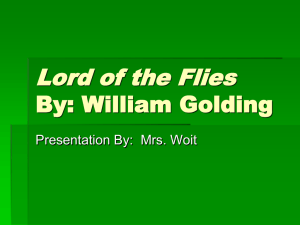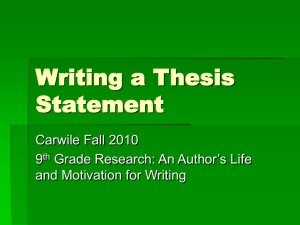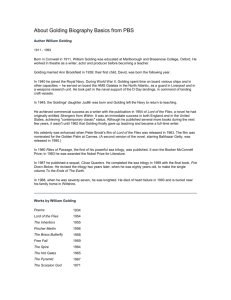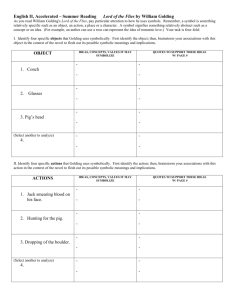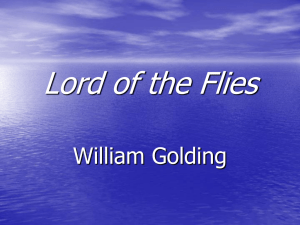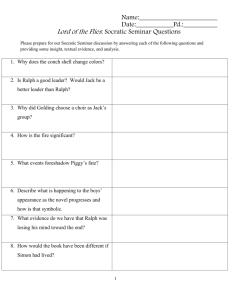Literary Devices in Lord of the Flies - ENG3U-SRB
advertisement
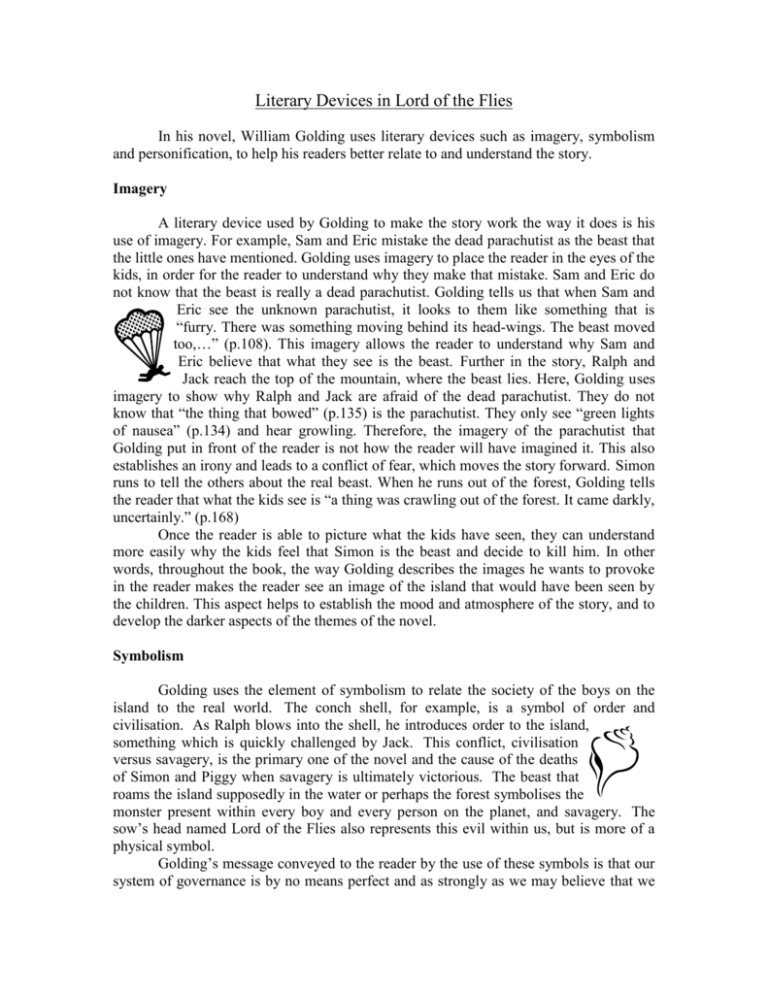
Literary Devices in Lord of the Flies In his novel, William Golding uses literary devices such as imagery, symbolism and personification, to help his readers better relate to and understand the story. Imagery A literary device used by Golding to make the story work the way it does is his use of imagery. For example, Sam and Eric mistake the dead parachutist as the beast that the little ones have mentioned. Golding uses imagery to place the reader in the eyes of the kids, in order for the reader to understand why they make that mistake. Sam and Eric do not know that the beast is really a dead parachutist. Golding tells us that when Sam and Eric see the unknown parachutist, it looks to them like something that is “furry. There was something moving behind its head-wings. The beast moved too,…” (p.108). This imagery allows the reader to understand why Sam and Eric believe that what they see is the beast. Further in the story, Ralph and Jack reach the top of the mountain, where the beast lies. Here, Golding uses imagery to show why Ralph and Jack are afraid of the dead parachutist. They do not know that “the thing that bowed” (p.135) is the parachutist. They only see “green lights of nausea” (p.134) and hear growling. Therefore, the imagery of the parachutist that Golding put in front of the reader is not how the reader will have imagined it. This also establishes an irony and leads to a conflict of fear, which moves the story forward. Simon runs to tell the others about the real beast. When he runs out of the forest, Golding tells the reader that what the kids see is “a thing was crawling out of the forest. It came darkly, uncertainly.” (p.168) Once the reader is able to picture what the kids have seen, they can understand more easily why the kids feel that Simon is the beast and decide to kill him. In other words, throughout the book, the way Golding describes the images he wants to provoke in the reader makes the reader see an image of the island that would have been seen by the children. This aspect helps to establish the mood and atmosphere of the story, and to develop the darker aspects of the themes of the novel. Symbolism Golding uses the element of symbolism to relate the society of the boys on the island to the real world. The conch shell, for example, is a symbol of order and civilisation. As Ralph blows into the shell, he introduces order to the island, something which is quickly challenged by Jack. This conflict, civilisation versus savagery, is the primary one of the novel and the cause of the deaths of Simon and Piggy when savagery is ultimately victorious. The beast that roams the island supposedly in the water or perhaps the forest symbolises the monster present within every boy and every person on the planet, and savagery. The sow’s head named Lord of the Flies also represents this evil within us, but is more of a physical symbol. Golding’s message conveyed to the reader by the use of these symbols is that our system of governance is by no means perfect and as strongly as we may believe that we are civilised enough to continue order, under extensive circumstances this is rarely true. The boys on the island must all fight their desire to put themselves above all else. Without the use of these symbols, this conflict and theme of the novel would be impossible for the reader to comprehend. They would be unable to relate the terrible experiences of the boys to their own life. Symbolism is essential to Lord of the Flies as it is the basis of the conflict and allows the reader to apply the author’s message to their own society. Personification In Lord of the Flies, personification is used to unify the characters with their environment. One example of personification is found after Piggy is killed, after his body falls to a rock near the edge of the sea. “Then the sea breathed out again in a long slow sigh, the water boiled white and pink over the rock; and when it went, sucking back again, the body of Piggy was gone.”(p.201) The sea “breathing out a long slow sigh” indicates a sign of relaxation, similar to how Jack appears undisturbed by Piggy’s death. The personification used to describe the sea helps to make a better comparison between it and Jack, and leads the reader to a better understanding of Jack’s unawareness of one of the novel’s themes: the fallen nature of man. A second example is used to describe the signal fire: “…, but on the other the fire thrust out a savage arm of heat that crinkled hair on the instant.”(p.41) The signal fire being an important symbol of the boys’ desire to return to rules and order, Golding’s use of personification makes the fire seem alive, imitating the life and eventual loss of the characters’ desire to return home. In the novel, Golding uses the simpler and better-understood behaviour of young boys to portray his complex ideas of man’s true nature and its effects in creating a flawed society. He matches the characters’ environment with the less complex characters themselves, by attributing human qualities, which are both more relatable and more understandable for the reader, to the ideas and objects found on the island. As a result, the significance of these elements is simplified to a level more cohesive with the simplicity of the young boys, and in turn completes Golding’s depiction of the weaknesses of human civilization. Had Golding not used any imagery, symbolism, or personification whatsoever, readers would not have felt as connected to the story. The readers would not have been able to imagine themselves actually being there, and as a result of this, his message would not have been as powerful or heartfelt. The novel would likely not have been the success that it was without the connection to the reader to help drive Golding’s message about man’s true nature home.

